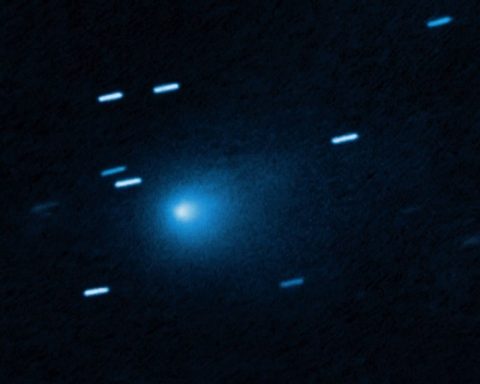- Biomass was selected in May 2013 as ESA’s seventh Earth Explorer mission to quantify forest carbon from space.
- The mission uses a P-band synthetic aperture radar at ~435 MHz (about 70 cm wavelength) with a 12-meter mesh reflector deployed in orbit to penetrate canopies and sense trunks.
- It employs fully polarimetric SAR (HH, HV, VH, VV) and SAR tomography to produce three-dimensional maps of forest structure and above-ground biomass.
- Biomass launched on 29 April 2025 aboard a Vega-C rocket (flight VV26) into a 666 km sun-synchronous orbit, carrying a ~1.25-tonne observatory.
- The project aims for wall-to-wall global biomass maps, delivering first 3D maps by late 2026 after about 17 months of data collection, with 2D updates every nine months thereafter during its five-year mission.
- The Amazon, Congo Basin, and Indonesian rainforests are the primary focus, together holding about 70% of global forest carbon.
- Beyond forests, the instrument can also map subsurface geology in arid regions (through 5 meters of dry sand) and probe ice structures in glaciers as secondary capabilities.
- Biomass data will support Paris Agreement reporting and UN-REDD+ by providing independent, consistent forest carbon density measurements for verification.
- The mission complements GEDI (NASA), NISAR (NASA-ISRO), and JAXA’s ALOS-based efforts by offering global wall-to-wall coverage at 200 m 2D resolution and higher sensitivity to dense biomass with P-band.
- First images were released in late June 2025 at the Living Planet Symposium, including a Bolivia scene showing green (volume scattering), red (double-bounce), and blue (surface scattering).
Background and Mission Objectives
The European Space Agency’s Biomass mission is a groundbreaking Earth observation program focused on measuring the amount of carbon stored in the world’s forests. Selected in 2013 as ESA’s seventh Earth Explorer research mission, Biomass was conceived to address a critical gap in our understanding of the global carbon cycle [1] [2]. By providing the first comprehensive measurements of forest biomass from space, Biomass aims to reduce uncertainties in how much carbon forests store and how those stocks are changing [3] [4]. This data is essential for climate science – forests absorb roughly one-third of humanity’s annual CO₂ emissions – yet current knowledge of forest carbon is limited by sparse ground data and partial satellite coverage [5] [6].
Mission Objectives: The Biomass satellite’s primary goal is to quantify terrestrial carbon stocks and fluxes by mapping the above-ground biomass (AGB) in forests worldwide [7]. Its stated objectives include:
- Reducing the large uncertainties in carbon flux estimates due to land-use change and deforestation [8].
- Supporting international treaties and programs like the UN’s REDD+ (Reducing Emissions from Deforestation and Forest Degradation), which require robust forest carbon data for implementation [9].
- Improving understanding of landscape-scale carbon dynamics and providing observations to improve Earth system models [10].
- Delivering information for forest resource management and ecosystem services, such as monitoring forest health and biodiversity [11].
These objectives reflect Biomass’s dual role as both a science mission and a practical tool. With more precise forest carbon maps, scientists can better model climate change, and policymakers can track progress toward climate goals like net-zero emissions. In fact, Biomass data will feed into efforts like the Paris Agreement’s Global Stocktake, providing countries with consistent, “unbiased assessments of all of Earth’s biomass” and how it is changing [12] [13]. The mission is expected to fundamentally change our understanding of Earth’s carbon balance, says Prof. Shaun Quegan (University of Sheffield), who led the mission’s scientific proposal [14]. “This mission will give us unprecedented insight into the structure of forests across the world and how changes in forests – both losses from deforestation and gains due to regrowth – are affecting the amount of CO₂ going into our atmosphere. The study will essentially weigh forests – it will tell us their weight and height, and we will be able to see how they are changing over time,” Quegan explains [15].
P-Band Radar Technology: Seeing the Forest for the Trees
At the heart of the Biomass spacecraft is a novel P-band synthetic aperture radar (SAR) – the first P-band radar ever flown in space [16]. P-band refers to a very low radio frequency (~435 MHz) with a wavelength around 70 centimeters, much longer than the X-, C- or L-band radars used by previous Earth satellites [17] [18]. This long wavelength gives Biomass a kind of X-ray vision for forests: the radar signal can penetrate through the leaves and canopy and bounce off the larger woody components of trees – the trunks, large branches, and stems [19] [20]. Those woody parts contain the bulk of a tree’s carbon, so by sensing them, Biomass can directly measure forest biomass and height in a way no other space mission has done before [21] [22].
How P-Band SAR Works: Synthetic aperture radar emits pulses of microwave energy and measures the return signals after they interact with the target (in this case, forests). Because an electromagnetic wave interacts most strongly with objects about the same size as its wavelength, Biomass’s 70 cm radar “sees” big structures like trunks and thick branches, while smaller items like leaves barely register [23] [24]. This allows the radar to effectively “see through” the leafy canopy and image the forest’s interior structure. In contrast, shorter wavelengths (like C-band ~5 cm or even L-band ~23 cm) mostly reflect off leaves or the upper canopy, missing the hidden mass below [25] [26]. The P-band radar on Biomass operates in a fully polarimetric mode, sending and receiving pulses in different polarizations (HH, HV, VH, VV). By combining these channels, scientists generate false-color images where different scattering mechanisms show up as colors – for example, multiple-bounce reflections within tree volume appear green, double-bounce from trunks appear red, and surface scattering appears blue [27] [28]. This radar imaging technique yields rich information about forest structure.
Perhaps most importantly, Biomass will use SAR tomography to map forests in 3D. By collecting multiple P-band images of the same area from slightly different angles (achieved as the satellite’s orbit repeats), the mission can reconstruct a vertical profile of the forest – essentially a 3D radar image of forest volume [29]. This tomographic approach enables direct measurement of forest height and above-ground biomass, rather than just producing a 2D picture [30]. In the satellite’s initial mission phase, it will acquire clusters of images over the same region in rapid succession to build 3D maps of forest structure [31]. During the later phase, the spacecraft will revisit forests over months and years to detect changes in biomass (e.g. from growth or deforestation) by comparing repeated measurements [32] [33].
Engineers had to overcome significant challenges to fly a P-band radar. The satellite carries a huge 12-meter mesh antenna reflector – about the size of a tennis court – needed to focus the long-wavelength radar beam [34] [35]. This golden, umbrella-like reflector (built by L3Harris) was stowed for launch and successfully deployed in orbit one week later, unfolding in a delicate choreography captured by an on-board camera [36] [37]. Flying a radar at 435 MHz also required special permission, since this part of the radio spectrum was traditionally reserved for military and communication uses [38]. ESA worked with the International Telecommunication Union (ITU) to secure a protected frequency allocation for Biomass’s science observations [39].
The result is a one-of-a-kind radar observatory. Biomass can see day or night and through clouds (an inherent advantage of radar) and now, with P-band, through dense vegetation and even dry soils. Its signals are expected to penetrate up to 5 meters into dry sand – meaning the mission can also reveal subsurface features like ancient riverbeds under desert dunes [40] [41]. P-band waves can even pass deeper into glacier ice than shorter radar bands, potentially exposing internal layers of ice sheets and improving ice velocity measurements [42]. These secondary capabilities (mapping subsurface geology in arid regions and probing ice structure) are exciting add-ons, but the core mission remains forest biomass. As ESA’s Director of Earth Observation Programmes, Simonetta Cheli, put it: “With [Biomass], we’re another significant step closer to unlocking unprecedented knowledge about the world’s forests, including crucial data on carbon stocks and fluxes” [43] [44].
Climate, Forest Management, and Carbon Accounting Significance
The data from Biomass is eagerly anticipated by climate scientists, foresters, and policymakers alike. Forests are a linchpin of the global carbon cycle – often dubbed the “Earth’s green lungs” – because they absorb roughly 8 billion tons of CO₂ from the atmosphere each year through photosynthesis [45] [46]. Healthy, growing forests act as carbon sinks, slowing climate change, whereas deforestation and degradation release that stored carbon back into the air, fueling global warming [47] [48]. Despite this importance, there is still large uncertainty about exactly how much carbon is stored in forests worldwide and how it is changing year to year [49] [50]. Biomass will fill this knowledge gap by providing consistent, high-resolution measurements of forest carbon stocks on a global scale.
Climate Science: A more accurate picture of forest carbon is critical for climate modeling and projections. By reducing uncertainties in land carbon fluxes, Biomass data will improve the land component of Earth system models and help scientists predict the pace of climate change under different scenarios [51]. “The role of forests in the global carbon cycle is not fully understood… we are lacking data about carbon stocks and fluxes and how forests react to climate change,” explains Dr. Björn Rommen, ESA’s Biomass Mission Scientist [52]. With Biomass mapping forest growth, mortality, and disturbance, researchers can better determine whether particular regions are net carbon sources or sinks. These insights feed directly into the global carbon budget – accounting for where carbon is being stored or emitted on Earth. According to the UK’s National Centre for Earth Observation (NCEO), the mission will provide a “more accurate global carbon budget” and reveal how tropical forests in particular are contributing to or mitigating climate change [53] [54]. It will also enable detection of trends and potential tipping points (for example, if warming and drought start turning the Amazon from a sink into a source). “Data from the Biomass mission will give us a true measure of the carbon regulation that forests provide, knowledge of the trajectories of these forests at a time of rapid change, and an assessment of their vulnerabilities to climatic tipping points,” says Professor John Remedios, Director of NCEO [55].
Forest Management: For those on the ground managing and conserving forests, Biomass offers a powerful new monitoring tool. The satellite will be able to map deforestation, forest degradation, and regrowth over its five-year lifetime, tracking how timber harvesting, fires or storms impact forest carbon stocks [56] [57]. Because it can identify even subtle biomass losses, Biomass data can help authorities pinpoint illegal logging or encroachment in remote tropical regions [58]. Conversely, it can verify gains from reforestation or restoration projects. Having wall-to-wall biomass maps every 9 months (after the initial 3D mapping phase) will allow countries to see where forests are declining or recovering in near-real-time [59] [60]. This level of insight is especially valuable in the tropics – places like the Amazon, Congo, and Indonesian rainforests – where ground surveys are sparse. Those three regions hold roughly 70% of global forest carbon, yet their exact carbon budget impacts have been hard to quantify until now [61] [62]. “The primary focus… is on tropical forests, where data is scarce. These regions store the majority of the world’s forest carbon and are where most changes in forest biomass take place,” notes Dr. Rommen [63]. By regularly measuring these forests, Biomass will show which areas are losing carbon fastest and which are recovering, information that can guide conservation initiatives.
Carbon Accounting and Policy: Perhaps the most immediate application of Biomass data will be in international climate policy and carbon accounting. Under the Paris Agreement, countries must report their greenhouse gas emissions and removals, including those from land-use and forestry. Until now, such reporting has relied on ground inventories and coarse satellite estimates, often with high uncertainties – a challenge for implementing programs like REDD+, which financially reward developing countries for reducing deforestation. Biomass directly answers this need by providing consistent global measurements of forest carbon density. “This data is valuable for governments committed to reducing carbon emissions and for policy-related activities such as those under UN-REDD+ or the UNFCCC,” says Rommen, emphasizing its role in climate agreements [64]. With Biomass, a country’s claims of forest conservation or reforestation gains can be verified by an independent space-borne sensor. This transparency can build trust in carbon credit markets and performance-based conservation funding. The mission essentially offers an MRI for Earth’s forests, giving policymakers unprecedented confidence in how much carbon is stored in any given region and how it’s changing. ESA’s Climate Change Initiative team has already been developing global biomass datasets by merging various satellites, and they note that Biomass will greatly enhance these carbon maps, particularly in tropical developing nations [65] [66]. By supporting better carbon accounting, Biomass data can inform national climate action plans, help set more accurate emissions targets, and track progress toward global climate goals.
Mission Timeline: From Concept to Launch
The journey of the Biomass mission spans over a decade of development. After being proposed by a team led by Prof. Shaun Quegan, Biomass was selected in May 2013 as an ESA Earth Explorer mission, winning out for its scientific merit and innovative technology [67]. It then took several years to secure funding and refine the design. By 2016, ESA had contracted Airbus Defence and Space in the UK to build the satellite, a project valued at €229 million [68]. Assembly and testing of the spacecraft took place in Stevenage, UK, and Toulouse, France, involving a coalition of over 50 companies across Europe [69]. Originally slated for launch in the early 2020s, Biomass faced schedule slips – its initial launch target of 2020 was pushed back due to technical and programmatic delays, including adjustments to launch vehicles [70] [71].
By early 2025 the satellite was finally ready. In February 2025, Biomass was shipped from Europe to the launch site in Kourou, French Guiana [72] [73]. There it was integrated with a Vega-C rocket (flight VV26). Launch occurred on 29 April 2025 at 09:15 UTC (11:15 CEST), with Vega-C lofting the 1.25-tonne observatory into a 666 km sun-synchronous orbit [74] [75]. Less than an hour after launch, ground stations picked up the first signal from Biomass, confirming the satellite was alive in orbit [76].
The days following launch were part of the critical Launch and Early Orbit Phase (LEOP). During this time, engineers carefully deployed Biomass’s unique hardware. A major milestone was unfolding the 7.5 m support boom and 12 m mesh antenna – a multi-step process likened to opening a giant umbrella in space [77] [78]. By 7 May 2025, just a week post-launch, ESA confirmed the antenna was fully deployed and locked in place [79] [80]. “I’m delighted to see Biomass successfully deploy its remarkable antenna – a major milestone for one of our most pioneering Earth Explorer missions,” said Simonetta Cheli at the time [81] [82].
With the antenna open, Biomass moved into the commissioning phase, a six-month period of instrument calibration, testing and fine-tuning (expected to last through late 2025) [83]. Commissioning involves checking the radar’s performance, calibrating it against ground targets and airborne measurements, and validating that the satellite’s data meets specifications. ESA invited scientists worldwide to help calibrate and validate Biomass’s data, including through field campaigns in various forests [84] [85]. Notably, even before launch, in 2024 researchers flew a P-band radar on a test aircraft over Antarctic ice and other targets to simulate Biomass’s measurements for calibration purposes [86].
Despite still being in commissioning, Biomass’s first images were revealed just two months after launch, in late June 2025. At the Living Planet Symposium 2025 (a major Earth observation conference in Vienna), ESA unveiled a set of vivid false-color radar images – the inaugural data from Biomass’s P-band eye on Earth [87] [88]. The room of scientists and engineers reportedly burst into applause as these first views appeared on screen [89]. “An exclamation of awe, excitement and cheers erupted… as a striking new window into Earth’s forests, deserts and glaciers opened with the release of the first images,” one account described [90]. For the team behind Biomass, the moment was emotional. “It was extremely emotional, because it was the work of hundreds of people,” recalled Simonetta Cheli, noting that the images are “very symbolic of the effort behind the scenes and the potential that this mission has.” [91] [92]
The mission’s timeline looking forward includes completing commissioning by late 2025, after which routine science operations will begin. Biomass’s nominal mission is five years, during which it will continuously scan Earth’s forests. According to mission plans, the satellite will produce its first 3D global biomass maps after about 17 months of data collection (combining passes to build up tomographic imagery) [93]. This means by late 2026, we can expect the first detailed global map of forest carbon stocks derived from Biomass. After that, the team intends to generate updated biomass maps approximately every 9 months, but without full 3D tomography – these 2D updates will still capture changes in biomass over time [94]. By the end of its five-year life (around 2030), Biomass will have captured at least eight seasonal cycles of the world’s forests, providing an unprecedented record of how Earth’s forests grow, shrink, and respond to climate influences over the latter 2020s [95].
Early Data and Initial Findings
Although it is early days for the Biomass mission, the first datasets returned are already demonstrating the power of P-band radar. ESA has released several false-color radar images from the commissioning phase that hint at the rich information content to come [96] [97]. One of the first images – showcased at the Living Planet Symposium – covers a region of Bolivia, a country that has suffered significant deforestation in recent decades. The false-color P-band image (see below) depicts the landscape in striking hues: green areas denote intact rainforest, red patches show forested wetlands and floodplain forests, and blue-purple tones correspond to open grasslands, with black lines tracing the courses of rivers [98] [99]. The Beni River winds across the scene, its undammed waters freely meandering through the lowland Amazon basin [100] [101].
These early images are already yielding insights. Because Biomass’s radar uses multiple polarization channels, researchers can interpret the colors to infer forest characteristics. For example, in the Bolivia image, the prevalence of green (volume scattering) indicates lush, multi-layered rainforest canopy, whereas bright red patches (double-bounce signals) suggest swampy forests or floodplains where the radar likely reflected between trunks and water surfaces [102] [103]. Blue regions (surface scattering) correspond to open areas like grassland or farmland where the radar mostly bounces off the ground [104]. This multi-channel radar imagery is far more than just a pretty picture – it encodes structural information that, once calibrated, will translate into estimates of biomass density and forest height.
Importantly, the Biomass team emphasizes that the true strength of the mission lies not in single snapshots but in combining multiple observations. Initial images are being used to verify that the instrument is working as expected (and indeed they show “everything is functioning smoothly”, according to ESA’s Project Manager Michael Fehringer [105]). However, these first looks cannot yet be used to calculate carbon quantities, since the calibration is still ongoing [106]. Over the coming months, the satellite will be systematically calibrated against ground measurements and cross-compared with other sensors. Scientists are already comparing Biomass radar imagery with optical images – for instance, an equivalent Sentinel-2 optical view of the Bolivian test site – to illustrate the added value of P-band. While the optical Sentinel-2 image shows only the canopy surface, the Biomass P-band image “offers significantly more information for quantifying forest carbon stocks,” thanks to its penetration of the full forest structure [107] [108].
Even in these preliminary images, some remarkable capabilities are evident. One early acquisition was a scene over northern Brazil (the Amazon) on 22 May 2025 – notably, the very first dataset Biomass downlinked [109]. In that image, wetland areas appear clearly in pink and red, demonstrating the radar’s ability to distinguish waterlogged forests and even see features of the forest floor beneath a dense canopy [110]. Another image covered a swath of Halmahera Island in Indonesia, revealing not only the tropical rainforest but also underlying topography and even volcanoes through the vegetation [111] [112]. Yet another was centered on Gabon, Central Africa, showing the Ivindo River slicing through dense equatorial forest and subtle variations in terrain beneath the green carpet of trees [113]. These examples underscore that Biomass’s long-wavelength radar can capture variations in forest height and ground elevation that were previously hidden. As one ESA scientist noted, “we’ll be looking at dense forests through completely new lenses… [P-band] enables us to see deeper into forest canopies than ever before and thus estimate biomass, and its changes, much more precisely.” [114] [115]
Beyond forests, the first-light images also teased the mission’s secondary targets. Biomass imaged part of the Sahara Desert (Tibesti Mountains in Chad), and the P-band radar could delineate ancient river channels and geological structures beneath the dry sand [116] [117]. Another image captured the Nimrod Glacier in Antarctica, with P-band peering through the ice to hint at internal layering and the bedrock topography of the Transantarctic Mountains [118]. These “bonus” results show the versatility of the instrument – effectively a proof-of-concept that such data on subsurface geology and ice could be obtained routinely. However, the main scientific output will be the forest biomass measurements. Each repeated pass of Biomass adds to a growing 3D picture of forest volume. As Fehringer explained during the first images release, “we’re still in the commissioning phase… fine-tuning the satellite to ensure it delivers the highest quality data for scientists to accurately determine how much carbon is stored in the world’s forests” [119] [120]. Those quantitative measurements – forest carbon in tons per hectare, forest heights in meters – will emerge once the mission has accumulated enough data and completed calibration, likely by 2026.
Even so, the quality of the first images has thrilled the mission team. “These first images are nothing short of spectacular – and they’re only a mere glimpse of what is still to come,” said Michael Fehringer [121]. ESA’s Director Cheli echoed that sentiment upon seeing the initial results: “Looking at these first images, it’s clear to see that our Earth Explorer Biomass satellite is set to deliver on its promise… [it] will provide a groundbreaking leap in our ability to understand Earth’s forests,” combining cutting-edge radar tech with scientific excellence to unlock insights into carbon storage and forest health [122]. In other words, the mission is on track to meet the lofty expectations set for it. Once fully operational, Biomass will transition from these colorful visualization images to its real work: producing quantitative maps of biomass density – essentially, carbon maps of Earth’s forests – that can be used in research and policy.
Comparisons to NASA and JAXA Forest Missions
ESA’s Biomass mission is arriving at a time when global forest observation is a high priority for many space agencies. It stands out as the first satellite to use P-band radar, but it is part of a broader international effort to measure Earth’s forests in new ways. NASA, for example, has taken a different approach with its forest monitoring missions. From 2019 to 2023, NASA operated the GEDI (Global Ecosystem Dynamics Investigation) instrument – a laser ranging lidar mounted on the International Space Station. GEDI’s lasers sent pulses of light down to Earth’s surface and measured the 3D structure of forests by the returning signals. In its first three years, GEDI collected billions of measurements of forest canopy height and vertical structure between 51.6°N and 51.6°S latitude [123] [124]. The data enabled NASA to release the first near-global map of above-ground biomass at ~1 km resolution, filling a key gap in climate research [125] [126]. However, GEDI’s coverage was limited to the ISS orbit (it missed high-latitude boreal forests) and its sampling was not continuous (lidar provides detailed profiles but only along narrow tracks). By contrast, Biomass will map forests wall-to-wall in its orbit path, including the high boreal zones and with complete spatial coverage at 200 m resolution [127] [128]. The two datasets will be complementary – in fact, previous global biomass maps have already combined satellite lidar (like GEDI) with radar and optical data [129] [130]. Biomass’s radar can also operate through clouds and at night, giving it an all-weather advantage over optical sensors or laser instruments.
Another upcoming mission is NISAR (NASA-ISRO SAR), a joint NASA–Indian Space Research Organisation satellite scheduled for launch in 2025. NISAR will carry L-band and S-band synthetic aperture radars primarily to measure Earth’s changing ecosystems, land surface and ice. While not dedicated solely to biomass, NISAR’s L-band (24 cm wavelength) radar will be used to monitor forest disturbances, regrowth, and wetlands dynamics at high resolution, and it can estimate biomass in less dense forests. However, L-band tends to saturate in very biomass-rich forests – meaning beyond a certain forest density, the radar signal can’t distinguish additional tree mass. P-band, with its longer wavelength, is expected to push that saturation point much higher, allowing Biomass to quantify the carbon in even the densest tropical rainforests [131] [132]. In essence, NISAR will provide frequent monitoring of land cover changes (useful for spotting deforestation events), whereas Biomass will provide the definitive measurement of how much carbon was lost or gained in those events. Together, data from missions like GEDI, NISAR, and Biomass will offer a more complete picture of forest structure – from canopy height profiles (GEDI), to disturbance mapping (NISAR), to absolute biomass and 3D structure (Biomass).
The Japan Aerospace Exploration Agency (JAXA) has also been a leader in radar-based forest mapping. JAXA’s satellites ALOS-1 (launched 2006) and ALOS-2 (launched 2014) carried L-band SAR sensors (PALSAR and PALSAR-2) that produced global forest cover and biomass maps. In fact, JAXA and ESA cooperated on the “ALOS Kyoto & Carbon Initiative” and the ESA Climate Change Initiative for Biomass, which used ALOS L-band data to estimate forest carbon stocks for select years [133] [134]. These efforts demonstrated the value of radar for forest monitoring but were still limited by L-band’s penetration and by data availability. Biomass is the next step: as JAXA noted in a joint release, its data will “extend the long-term record [of global biomass]… particularly across tropical regions” and improve the temporal frequency of biomass estimates [135] [136]. JAXA is also planning ALOS-4 with L-band radar, and NASA has proposed a GEDI-2 or similar lidar for the future. No other agency has a P-band mission, so Biomass is a unique pioneer. It required ESA’s willingness to demonstrate new technology under the Earth Explorer program, whereas agencies like NASA had considered but shelved a similar concept (the cancelled DESDynI mission in the early 2010s would have combined an L-band radar and a lidar for ecosystem monitoring). Now with Biomass on orbit, even those agencies will benefit – NASA and JAXA scientists will certainly incorporate Biomass P-band data into global carbon assessments, alongside their own missions.
In summary, Biomass complements these missions by providing the one measurement that has remained elusive: a truly global, high-resolution accounting of forest carbon density. “Upcoming satellite biomass missions will provide new opportunities to improve estimates of the state of forests and their living carbon pools,” noted one perspective in the journal Science [137]. Biomass is leading that charge, and its data, combined with lidar and other radar observations, will collectively enable a quantum leap in forest monitoring capabilities. As Professor Heiko Balzter (NCEO, University of Leicester) remarked, “The P-band SAR is pushing the boundaries of remote sensing technology… The images will no doubt transform our understanding of global forest carbon stocks and their changes over time.” [138].
Latest Developments and Looking Ahead
Since launch, there have been a number of news updates and early scientific analyses related to the Biomass mission. In May 2025, ESA’s Climate Office released the longest-ever satellite-derived biomass dataset (CCI Biomass v6), which compiled observations from 2007–2022 to map forest carbon stocks and trends [139] [140]. This dataset – incorporating Sentinel-1 C-band radar, JAXA’s ALOS L-band data, and NASA’s GEDI lidar – set the stage for Biomass by highlighting regions of change and uncertainty. The researchers behind it explicitly noted that, “following the successful launch of the Biomass mission in April 2025, [they] anticipate the dataset will soon be further enhanced by data from the mission itself, particularly across tropical regions.” [141] In other words, the community is ready to plug Biomass data into existing models and products as soon as it’s available.
ESA has also been engaging the public with the mission’s progress. Media releases like “Biomass launched to count forest carbon” (ESA, 29 April 2025) announced the successful launch and described the mission’s goals [142] [143]. Follow-up stories such as “Forest satellite’s big antenna opens up” (7 May 2025) provided behind-the-scenes insight into the technical operations, even showing a “selfie” of the antenna deployment captured by an onboard micro-camera [144] [145]. By 23 June 2025, the headline “Biomass satellite returns striking first images of forests and more” was splashed across ESA’s and science news websites, accompanied by vivid imagery [146]. Publications like Phys.org, Space.com, and Smithsonian Magazine picked up the story, emphasizing how these colorful radar images hint at the mission’s potential to map carbon like never before [147] [148]. For instance, Smithsonian Magazine highlighted the Bolivia image and quoted ESA’s Nuno Carvalhais on seeing forests “through completely new lenses” [149], while Space.com interviewed Simonetta Cheli about the excitement of the first results [150]. Such coverage underscores that even early in its life, Biomass is being recognized as a game-changer for forest monitoring.
On the scientific publication front, it will take some time for Biomass’s calibrated data to be analyzed and published in peer-reviewed journals. However, related research is already appearing. A 2023 article in Science (“Looking beyond the trees for carbon storage”) discussed the promise of upcoming missions like Biomass for improving biomass estimates [151]. And Earth observation conferences in 2024 and 2025 have sessions dedicated to Biomass’s expected contributions. We can anticipate that by 2026, we’ll see the first scientific papers reporting Biomass-based estimates of global forest carbon, comparisons with model predictions, and case studies of regional carbon changes detected by the satellite. There is also likely to be cross-validation work – for example, comparing Biomass’s biomass measurements with those from ground plots, airborne surveys (like NASA’s Airborne Tropicarms SAR or Lidar campaigns), and other satellites (NISAR, GEDI, ICESat-2). In essence, the mission will quickly become integrated into the broader carbon cycle research community.
Implications for Climate Policy: Perhaps the most profound impact of Biomass will be on how the world tracks progress in mitigating climate change. With deforestation accounting for roughly 10% of global CO₂ emissions, having timely and accurate data on forest carbon loss is crucial for climate action. Biomass’s maps will inform the Global Stocktake (the periodic assessment of collective progress under the Paris Agreement) by providing clear evidence of whether forest carbon sinks are growing or shrinking. Countries aiming to achieve their Nationally Determined Contributions (NDCs) can use the data to identify where forest conservation or restoration efforts are succeeding and where more effort is needed. Additionally, carbon offset markets – which rely on confidence that preserving a forest is genuinely offsetting emissions – will be bolstered by having an objective, satellite-derived measurement of carbon saved. This could standardize and bring more transparency to carbon credit projects involving reforestation or avoided deforestation, as all parties can refer to the same Biomass data for verification. As noted earlier, the mission directly supports programs like UN-REDD+ by providing the evidence base to quantify emissions reductions from forest protection [152].
Beyond climate mitigation, Biomass has biodiversity and ecological applications as well. Forest biomass is linked to habitat structure – for instance, old-growth forests with high biomass often support more biodiversity. The mission’s data can highlight intact high-biomass forests that are conservation priorities, as well as degraded areas that might be targets for ecological restoration. It also contributes to understanding ecosystem services; forests with more biomass typically provide greater services in terms of carbon sequestration, microclimate regulation, and watershed protection [153]. Knowing the distribution of these “carbon heavy” forests can thus feed into broader environmental policy and land management decisions.
As the Biomass satellite continues its mapping, the world is poised to gain, for the first time, a dynamic global forest carbon atlas. ESA’s mission scientists emphasized that this is not just a one-off snapshot, but a tool for tracking change. “Both deforestation and forest growth have impacts on the carbon cycle… Data on biomass, especially tropical forest biomass, is very limited… Biomass is able to penetrate cloud cover and measure forest biomass more accurately than current technology,” NCEO noted in a launch briefing [154] [155]. With each 9-month update, we will see where forests are disappearing and where they are rebounding. This knowledge is power: it allows for targeted action, whether it’s dispatching resources to curb illegal logging in a hotspot or investing in reforestation where it will have the most carbon benefit.
In the words of ESA’s Cheli, Biomass exemplifies how “combining cutting-edge radar technology with scientific excellence” can unlock vital insights for our planet [156]. By scanning the canopy in P-band, the mission is effectively weighing Earth’s forests from space, tree by tree and ton by ton of carbon. As we face the intertwined challenges of climate change and biodiversity loss, such information is invaluable. The data from Biomass will feed into climate models, inform international policy, and guide on-the-ground conservation – a prime example of space technology enabling sustainable stewardship of Earth’s resources. The coming years with Biomass promise a new era of understanding how our forests are changing, and with that understanding comes the opportunity to manage and protect these critical carbon reservoirs more effectively than ever before.
Sources:
- ESA, “Biomass launched to count forest carbon,” Apr. 29, 2025 [157] [158]
- ESA, “Biomass satellite returns striking first images of forests and more,” Jun. 23, 2025 [159] [160]
- Airbus, “Biomass: a satellite to look inside the world’s forests like never before,” Apr. 2025 [161] [162]
- National Space Centre (UK), “Biomass: Weighing Carbon Stored in Forests,” 2025 [163] [164]
- AZoCleantech, “Weighing Earth’s Forests Using a Space Umbrella,” Sep. 21, 2022 [165] [166]
- NCEO, “Mission to Map the World’s Forests Launches,” Apr. 29, 2025 [167] [168]
- ESA Climate Office, “Longest-Ever Dataset on Forest Biomass Released,” May 6, 2025 [169] [170]
- Space.com, “ESA’s Biomass satellite releases 1st views of Earth,” Jun. 23, 2025 [171] [172]
- Smithsonian Magazine, “Colorful Satellite Views Reveal Our Forests… New Biomass Mission,” Apr. 2025 [173] [174]
- Wikipedia, “Biomass (satellite),” (various background info) [175] [176]
References
1. en.wikipedia.org, 2. www.nceo.ac.uk, 3. en.wikipedia.org, 4. en.wikipedia.org, 5. www.airbus.com, 6. www.airbus.com, 7. en.wikipedia.org, 8. en.wikipedia.org, 9. en.wikipedia.org, 10. en.wikipedia.org, 11. en.wikipedia.org, 12. www.azocleantech.com, 13. www.azocleantech.com, 14. www.spacecentre.co.uk, 15. www.azocleantech.com, 16. www.esa.int, 17. phys.org, 18. www.airbus.com, 19. phys.org, 20. www.airbus.com, 21. www.airbus.com, 22. www.airbus.com, 23. www.airbus.com, 24. www.airbus.com, 25. www.airbus.com, 26. www.esa.int, 27. www.esa.int, 28. www.esa.int, 29. www.airbus.com, 30. www.airbus.com, 31. www.airbus.com, 32. www.airbus.com, 33. www.airbus.com, 34. www.esa.int, 35. www.esa.int, 36. www.esa.int, 37. www.esa.int, 38. www.azocleantech.com, 39. www.azocleantech.com, 40. www.smithsonianmag.com, 41. www.esa.int, 42. www.esa.int, 43. www.esa.int, 44. www.esa.int, 45. www.esa.int, 46. www.smithsonianmag.com, 47. www.esa.int, 48. www.smithsonianmag.com, 49. www.esa.int, 50. www.airbus.com, 51. en.wikipedia.org, 52. www.airbus.com, 53. www.nceo.ac.uk, 54. www.nceo.ac.uk, 55. www.nceo.ac.uk, 56. www.airbus.com, 57. www.airbus.com, 58. www.airbus.com, 59. www.nceo.ac.uk, 60. www.nceo.ac.uk, 61. www.airbus.com, 62. www.nceo.ac.uk, 63. www.airbus.com, 64. www.airbus.com, 65. climate.esa.int, 66. climate.esa.int, 67. en.wikipedia.org, 68. en.wikipedia.org, 69. www.esa.int, 70. en.wikipedia.org, 71. en.wikipedia.org, 72. en.wikipedia.org, 73. en.wikipedia.org, 74. www.esa.int, 75. en.wikipedia.org, 76. www.esa.int, 77. www.esa.int, 78. www.esa.int, 79. www.esa.int, 80. www.esa.int, 81. www.esa.int, 82. www.esa.int, 83. www.esa.int, 84. www.esa.int, 85. www.esa.int, 86. en.wikipedia.org, 87. www.esa.int, 88. www.esa.int, 89. www.space.com, 90. www.space.com, 91. www.smithsonianmag.com, 92. www.smithsonianmag.com, 93. www.nceo.ac.uk, 94. www.nceo.ac.uk, 95. en.wikipedia.org, 96. www.esa.int, 97. www.esa.int, 98. www.esa.int, 99. www.esa.int, 100. www.esa.int, 101. www.esa.int, 102. www.esa.int, 103. www.esa.int, 104. www.esa.int, 105. www.esa.int, 106. www.esa.int, 107. www.esa.int, 108. www.esa.int, 109. www.smithsonianmag.com, 110. www.smithsonianmag.com, 111. www.esa.int, 112. www.smithsonianmag.com, 113. www.esa.int, 114. www.smithsonianmag.com, 115. www.smithsonianmag.com, 116. www.smithsonianmag.com, 117. www.esa.int, 118. www.esa.int, 119. phys.org, 120. phys.org, 121. www.space.com, 122. www.esa.int, 123. www.nasa.gov, 124. www.nasa.gov, 125. www.nasa.gov, 126. www.nasa.gov, 127. en.wikipedia.org, 128. en.wikipedia.org, 129. climate.esa.int, 130. climate.esa.int, 131. www.airbus.com, 132. www.airbus.com, 133. www.satnavi.jaxa.jp, 134. www.satnavi.jaxa.jp, 135. climate.esa.int, 136. climate.esa.int, 137. www.science.org, 138. www.nceo.ac.uk, 139. climate.esa.int, 140. climate.esa.int, 141. climate.esa.int, 142. www.esa.int, 143. www.esa.int, 144. www.esa.int, 145. www.esa.int, 146. www.esa.int, 147. phys.org, 148. www.smithsonianmag.com, 149. www.smithsonianmag.com, 150. www.space.com, 151. www.science.org, 152. www.airbus.com, 153. en.wikipedia.org, 154. www.nceo.ac.uk, 155. www.nceo.ac.uk, 156. www.esa.int, 157. www.esa.int, 158. www.esa.int, 159. www.esa.int, 160. www.esa.int, 161. www.airbus.com, 162. www.airbus.com, 163. www.spacecentre.co.uk, 164. www.spacecentre.co.uk, 165. www.azocleantech.com, 166. www.azocleantech.com, 167. www.nceo.ac.uk, 168. www.nceo.ac.uk, 169. climate.esa.int, 170. climate.esa.int, 171. www.space.com, 172. www.space.com, 173. www.smithsonianmag.com, 174. www.smithsonianmag.com, 175. en.wikipedia.org, 176. en.wikipedia.org










